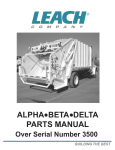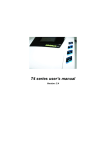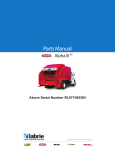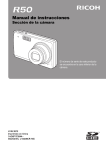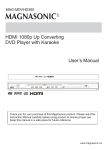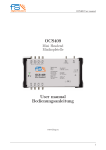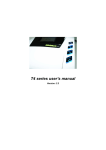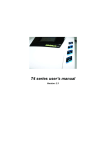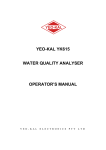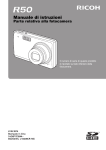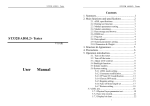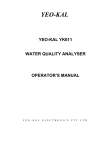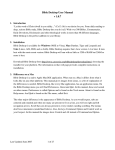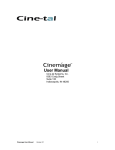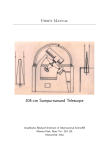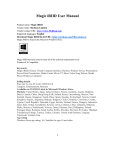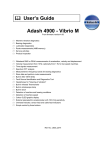Download User Manual
Transcript
F805 Series Reader User Manual Version: V2.0.0 Dear Customers: Thanks for your trust and support! We will be happy to provide you with comprehensive service and technical support. This manual will introduce the specific using methods of our reader SAAT-F805 to you you. In order to operate the readers safely & efficiently and make full use of the functions & features, please read this manual and the doc. in CD in details before installation. You will experience the efficiency and convenience with our products. Your comments & suggestions are warmly welcome during your operation on our products. We will be always at your side. Shenzhen Aerospace Innotech Corporation Limited Address: Floor 8, Block B, SZAAT Building,10th Road Kejinan,Hi-Tech Park,Nanshan District, Shenzhen City,Guangdong Province of China Post Code: Tel: Fax: 518057 +86-755-26727074 +86-755-26727070 Mail Box: [email protected] Web: http://www.htrfid.com This manual is suitable for the following readers: F805B reader F805E reader F805S reader When this manual is written it is supposed that readers have basic knowledge over RFID and computer. The technical words, such as RFID, Radio Frequency & Ethernet etc in this manual, are not specifically introduced. Please refer to other reference books or consult our technical department for support. The following marks would appear in our manual, the meaning are as below: Warning If it disobey the restricted operations or using environments, it might be harm to human health or damage equipments. Advice Follow the advised instructions, the results might be better. Table of Contents Part I Reader Introduction ................................................................. ..........1 1. F805 Reader Introduction ..................................................................................1 2. Technical Parameter ..........................................................................................1 3. Reader Function Introduction ............................................................................2 3.1 System Function ........................................................................................................................ 2 3.2 Tag Operation Function ............................................................................................................. 5 Part II Reader Structure and Interface ........................................................ 6 1 Reader Structure ...............................................................................................6 2 Reader Interface Specification ...........................................................................6 2.1 Front Panel.............................................................................................................................. 7 2.2 Rear Panel ............................................................................................................................... 7 2.3 Top Panel .............................................................................................................................. 10 2.4 Bottom Panel ........................................................................................................................ 11 Part III Installation and Debugging ........................................................................................ 13 1 Installation Notes .............................................................................................13 2 Installation Preparation ....................................................................................14 3 Installation Methods .........................................................................................14 3.1. Fixing Reader ....................................................................................................................... 14 3.2. Connection Components....................................................................................................... 15 3.3. Reader Parameter Configuration .......................................................................................... 21 4 Control Reader Operations ..............................................................................21 4.1 Call API Function Package ................................................................................................... 21 4.2 Transmit Data Stream ........................................................................................................... 21 Part IV Routine Maintenance and Repair ................................................. 23 Common fault analysis and solve method ..............................................................23 Part V 1 1.1. 1.2. 1.3. 1.4. 1.5. 2 2.1 2.2 2.1 3 RFID Integration Application ........................................................ 28 Application assembly explain ...........................................................................28 Computer .............................................................................................................................. 28 Application software............................................................................................................. 28 RF cable ................................................................................................................................ 28 Antenna................................................................................................................................. 29 Communication cable ........................................................................................................... 29 Integration Application Reference ....................................................................30 Signal disturbance issue........................................................................................................ 30 RF Signal Attenuation /Reflex .............................................................................................. 30 Optimization method ............................................................................................................ 31 Special Remind ...............................................................................................33 3.1. 3.2. 3.3. The damage to human body.................................................................................................. 33 Disturbance by other devices ................................................................................................ 33 Application in special situation ............................................................................................ 33 Part VI 1 2 Transportation Requirements...........................................................................34 Storage Require ..............................................................................................34 Part VII 1 2 Transportation and Storage ........................................................ 34 Packaging and Accessory .......................................................... 35 Product Packaging ..........................................................................................35 Accessories .....................................................................................................35 Part VIII After Sales Service..................................................................... 36 1 After Sale Service ..............................................................................................36 2 Contact Information .............................................................................................36 II Part I Reader Introduction 1. F805 Reader Introduction F805 RFID reader is independently developed by Shenzhen Academy of Aerospace Technology, aiming for ISO18000-6B and ISO1800-6C (EPC Class1 Gen2) protocol standard. With the characteristics of long reading-range, stability & reliability, massive functions and expandability, F805 could be applied in many applications: logistic control, transportation management, asset management and plant supervision, and so on. F805 reader provides multi communication interfaces, including RS-232, Ethernet and USB interfaces. F805 also provides several expandable interfaces, RS-485, Wiegand and CAN bus, and is capable of expanding GPRS module and other wireless data transmission modules. This series reader has the functions of 2-channel IO input signal detection and 4-channel IO signal controllable output. Considering of different requirements on RFID systems, F805 is modular designed. Except for the default firmware interfaces on F805, other interfaces are customizable. F805 operates in UHF frequency band, RF index complying with relative standards on UHF RFID devices, and it has been approved by the China Radio Management Committee, approved code: 2008DP3325. Record info could be found on the website: (http://www.srrc.org.cn/xhhzcx/Pages/WP_Search.aspx) 2. Technical Parameter F805 Reader parameters as following: 1 Technical Parameters Description Operating Frequency 860~920MHz, frequency band adjustable Tag Protocol ISO18000-6B、ISO18000-6C (EPC Class1 Gen2) FM Mode FHSS or Fixed Frequency Frequency Points 16 points (frequency points adjustable) Data Transmission Ratio 40kbps Antenna Port 4 SMA RF interface Modulation ASK RF Power Output +20dBm~ +30dBm @50Ω load, 1dBi each step Reading Range 0~15m (depends on antenna gain) Writing Range 0~5m Communication Interface RS-232, USB2.0 and 10M/100M adaptive Ethernet interfaces Expandable Interface RS485, Wiegand 26/34 IO Port 4-channel output(2 for power adapter, 2 for relay), 2-channel input(level detection) Firmware Upgrade Support Serial Port Status Indicator Indicators for built-in buzzer, power adapter / antenna / tag-identifying/ communication Power Adaptor External Power Adapter(150~240V/50Hz) AC input, 12V/3A DC input Power Consumption 2W(standby), 10W(working) Casing Material Aluminium-Magnesium alloy die-casting Dimension 270 mm × 120 mm × 60mm Weight < 2.0Kg IP Rating IP54 Operating Temperature -20℃~60℃ Storage Temperature -40℃~80℃ Humidity 20%~90%(non-condensing) Operating frequency: The frequency of readers are related to local restrictions of UHF bands. Please confirm whether the frequency of readers comply to local frequency, i.e. China frequency band (920~925Mhz), Europe frequency band (865~868Mhz), North America frequency band (902~928Mhz), Japan frequency band (952~954Mhz), etc. 3. Reader Function Introduction This section illustrates functions and features of reader F805. 3.1 System Function 2 Multiple Communication Interfaces F805 reader provides multiple communication interfaces catering for different application environments: Standard RS-232 serial port, support speed range 9600~115200bps Standard 10M /100M Base-T Ethernet interface, support AUOTO-MIX function, identify cross-line or straight line and automatically switches send/receive channels. Standard USB2.0 interface Status Indicator F805 reader provides the following status indicators: power, antenna selection and antenna port carrier output, reading tag, data communication indications. At the same time, it is equipped with buzzer to indicate reader operation status. For specific definition, Section 2.2.3 would introduce the panel on reader. Reader Name Configuration User can set different name for each reader, and the set name could be stored and queried. Through this function, user can fast and easily find the connection established readers in different places, other than using IP address or label sticker to distinguish readers. This can also establish user-friendly database management. Antenna Port Disable and Enable The four antenna ports of F805 reader can be set as forbidden or allowed to use. When host computer is using a forbidden antenna port to operate, the reader would reject and return error code. In order to prevent a port without antenna operating, this would result in error operation or even damage to devices. When a reader is operating on tags in port rolling query method, the reader would select the allowed ports and neglect the forbidden ones. Independent Antenna Port Power Configuration The four antenna ports of F805 reader could be set with different power output parameter. When reader switches from one port to another, the power output is also transmitted into the appropriate port value. This feature enables users to configure appropriate power output for different antenna, when they are doing multi-antenna applications to optimize the 3 system. Independent Antenna Port Cycling Query Time Configuration The four antenna ports of F805 reader could be set with different query time. This feature enables users to configure appropriate working time for different antenna, when they are using cycling query for tag operation to optimize the system. Modify Ethernet Configuration Parameter In Real-time After modify the Ethernet configuration parameters of reader such as IP address, the reader would simultaneously update the parameter. It doesn't need restart or re-power. When using the Ethernet connection to modify Ethernet configuration parameters, the reader will use the original Ethernet configuration parameters to maintain connection and communication, until the current connection is cut off. The reader Ethernet configuration is immediately updated when it is cut off, and the host computer will use new Ethernet configuration parameters to establish connection with reader. When using other connecting methods to modify the Ethernet configuration parameters, the Ethernet configuration parameters will be updated immediately. Adaptive Reading Time When a reader is continuously operating on tags, use the interval reading mode to reduce power consumption and to decrease interference with other devices. F805 reader will automatically adjust the interval according to actual working status. When there's no tag within RF environment, it will auto-adjust to standby monitoring status and increase the interval; when detected tags within the RF range, the interval will be reduced. Through this way, the power consumption and tag operation efficiency is achieved. Control IO Output Reader provides 4 IO output interfaces: 2-way MOS controlling power output and 300mA output current, can be used for signal control or be used as power supply for other devices; the other two for the relay control output, providing 220V/500mA current control. The 4-way IO output can independently control the output status, input status including: high level, low level, positive pulse and negative pulse. IO Input Detection 4 Reader provides 2-way IO input detection function, which can detect IO input level status and return to the computer. 3.2 Tag Operation Function Tag Filtering Reader can be configured to support the label filtering. After start the tag filtering function, if reader gets a tag ID and sends to host computer successfully, within the configured time reader would filter the same tag ID, and it will send the tag ID again when the configured time out. This feature can reduce the duplication of the tag information on the network congestion and control computer data processing burden. This function has two parameters can be configured: 1) Filtering startup and shutdown; 2) Filtering time configuration, range from 100 milliseconds to 2 minutes. ISO18000-6B Tag Function Reader can read tags which are compatible with ISO18000-6B protocol, and read UID code of ISO18000-6B tags, read/write data bank data, lock and lock status query. ISO18000-6C Tag Function Reader can read tags which are compatible with ISO18000-6C protocol, and read EPC code of ISO18000-6C tags, read/write data bank data, lock and unlock. EPC Length Adaptive The EPC code length of ISO18000-6C protocol tag is changeable, and F805 can read/write EPC code of different length. TID Length Adaptive The TID code of ISO18000-6C tag is 8bytes, while many tag manufacturers keep TID code blank or only 4bytes. F805 can read TID code of different length. 5 Part II Reader Structure and Interface This chapter explains F805 reader structure, the external reader interface type and function definitions in details. 1 Reader Structure F805 reader casing is aluminum-magnesium alloy die cast, with better strength and EMC. RF interface and communication interface work in a different panel, which is easy for wiring and operation. Pic.2-1 Reader Structure Dimension 2 Reader Interface Specification This section explains the external interface of F805 panel for function definition and the 6 contents of the nameplate etc. 2.1 Front Panel Front panel is RF interface panel, 4 of them is used for RF output antenna ports, using standard SMA connectors. Pic. 2-2 F805 Reader Front Panel Sketch Map Interface Definition: “1”-Antenna Port 1 “2”-Antenna Port 2 “3”-Antenna Port 3 “4”-Antenna Port 4 When reader works, the antenna port must be connected to standard 50Ω antenna. If the port is not connected with antenna a 50Ω load is necessary, and set to be disabled, otherwise it could damage RF part of the reader circuit! 2.2 Rear Panel Rear panel includes power connector and communication interface, to supply power for reader, and communications capabilities of computer or control equipments. 7 Pic. 2-3 F805 Reader Rear Panel Sketch Map Interface Definition: “1”- DC power input port, standard XS-12 air connector “2”-Ethernet interface, standard RF-45, with network status indicator Yellow: Ethernet interface connection is normal; Green: Flashing indicates Ethernet interface is sending and receiving data “3”-USB interface, standard Type-B USB interface block “4”-RS-232 interface, standard DB9(female type) interface block. Pin number, signal name and signal flow of identification are as following (Pin number and DB9 socket marked with the same number): Table 2-1 DB9 interface pin marks Pin Number Signal Name Signal Flow 2 RXD RS-232 data input 3 TXD RS-232 data output 5 Gnd Grounding “5”- Expansion interface, using 14-bit standard EU regulation terminal for expanding other interfaces, and communicate with external device and IO input / output control function. Optional extension of a three-cable serial bus interface, two MOS output interface of control, two relay control outputs and two IO input test interface. Extension interface shown in Pic. 2-4. 8 Pic.2-4 F805 Reader Expansion Interface Sketch Map 1, 2, 3 are serial bus interfaces for expansion, marked "BUS". Expansion board is installed according to the internal differences can be configured for RS-485, CAN bus and Wiegand interface, it can also be expanded according to user needs to other interfaces, the corresponding marks as shown in Table2-2. Table.2-2 Corresponding Interface Marks BUS “+” “-” RS-485 Line-A Line-B Grounding CAN + - Grounding data1 data0 Grounding Wiegand Interface “G” *If there are other customized interfaces, they will be defined in the special document. 4, 5, 6 power output interfaces, under the control of the software can respectively output 300mA maximum current, the interface can be used to power external devices, and can also be used as general IO output control interface. Marks definition as following: “V1” corresponds to No. 4, as power output interface 1; “V2” corresponds to No. 5, as power output interface 2; “ ” corresponds to No. 6, as power output interface grounding; 9 Please note that when using this interface to connect the device's internal circuitry and load, avoiding connecting output interfaces directly to ground for short-circuit or overload. When use the output interface supply power to other devices, please take care of the output power. When power beyond the limit, reader would auto-cut off for circuit protection. 7, 8, 9, 10 are IO output ports, controlled by relay. Under the control of host computer, they can execute open and close state. They can load 220V/500mA current. Marks definition as following: “OUT1” corresponds to 7 &8, as IO output port 1 and normal open status; “OUT2” corresponds to 9 & 10, as IO output port 2 and normal open status; 11,12,13,14 are IO input ports, used for detecting external input level signal. The inputting level: 0.5V~16V is high, and 0V~0.5V is low. Marks definition as following: “IN1” corresponds to 11 & 12, as IO input ports 1, "+" (11) marked as positive, "-" (12) marked as negative. “IN2” corresponds to 13 & 14, as IO output ports 2, "+" (13) marked as positive, "-" (14) marked as negative. IO input to the internal using opto-coupler for photoelectric isolation; therefore, do not use voltage which is more than 16V at both ends of input pins. If you have special needs please contact SZAAT or our agent to provide solutions. 2.3 Top Panel 10 Pic.2-5 F805 Reader Top Panel Sketch Map There are 6 LED indicators on the top panel of F805 reader. Each indicator has a corresponding icon. Meaning of the numbers corresponding to the icon as follows: “1”-Power indicator, red and green, red means reader is using an external power supply, and green means remaining unused. “2”-Antenna port 1, red and green, green means antenna is available for use, and red means reader is using this antenna to transmit carrier or signal. “3”-Antenna port 2, red and green, green means antenna is available for use, and red means reader is using this antenna to transmit carrier or signal. “4”-Antenna port 3, red and green, green means antenna is available for use, and red means reader is using this antenna to transmit carrier or signal. “5”-Antenna port 1, red and green, green means antenna is available for use, and red means reader is using this antenna to transmit carrier or signal. “6”-Decoding, red and green, green means reader reads tag correctly, and red means remaining unused. F805 reader is equipped with buzzer for indicating working status. If reader starts and self-tests normally, the buzzer will sound three short beeps. If the system self-testing fails, the buzzer will be sounding five long beeps. If reader internal setup success, the buzzer will sound a short beep. 2.4 Bottom Panel Pic. 3-6 F805 Reader Bottom Panel Sketch Map 11 There are 4 mounting interfaces on the bottom panel, for installing the reader on the mounting bracket. There are nameplate, reader model, product serial number and manufacturer information, etc on the bottom panel. 12 Part III Installation and Debugging Please carefully read this chapter before installation and debugging F805 reader. 1 Installation Notes To ensure your personal & property security and equipment running well, before installing F805 reader, do the following preparations: Understanding of local power supply parameters; check the whether the voltage and frequency range comply with local power line. Under some circumstance, due to electrical load or other reasons, voltage range may be greater volatility, understand the working environment carefully and the actual working state of power supply voltage before using. Please use the three-phase power socket and ensure a good grounding! For an outdoor environment, the installing location of reader should be rain, moisture and sun proof, well-ventilated. The reader must be pre-tested for proper installation. Before installation, measure the distance between reader and components (such as between reader and antenna, reader and computer, reader and power plug), to buy cable and plan system reasonably. Note the transmission distance limitations and type of the serial cable / USB cable / network cable (straight line, cross line); If you use a relay device, please note that the actual total length of the relay equipment and delay of data transmission. Check the working environment of reader and tag whether there are some factors existing between reader and tags, such as some large metal objects blocking or reflecting. Carefully analyze the work electromagnetic environment of working place before installation, and check whether there are some special restrictions on wireless equipments 13 (such as hospital, airport). Knowing what are the devices working range within 900~960MHz (such as GSM base station), in order to reasonably configure the frequency and power of reader, if necessary it is recommended to use additional filtering components. If user has no sufficient experience at this, please feel free to contact HTRFID or its agent. When installing several readers under the same environment, please take care of the fixing methods and minimum distance between antennae, the frequency configuration to avoid interfering. 2 Installation Preparation Before installing F805 reader, please check the intactness of product function and completeness of files carefully. If there is any damage or shortage, please contact local supplier for replacement. Except for these, check whether the reader complies with the following installation conditions: 1.Meet the requirements of working environment (power and RF environment); 2.The tested reader working normal, interfaces in good condition; 3.The accessories are complete, and reach the required standard to fulfill a complete read/write application environment. 3 Installation Methods The appropriate installation methods mainly depend on its location. Usually, the readers are installed on the points where are safe and convenient for operation. Antenna installation should try to avoid pointing to prolonged personal staying location. 3.1. Fixing Reader According to the working environment and different installing location, the F805 reader has the following installation methods. 1.Desktop Installation 14 Put the reader on the work table, as Pic. 3-1 Be noted before choosing this installation method: The reader and its cables would not be cut down by accident, and causing disconnection or power cut off by incident. If there's vibration or possibility of tilt, please take some fixing measures. Pic.3-1 Desktop Installation 2.Wall Mount Installation Make use of the accessories which F805 owns (mounting screws, nuts) to fix the reader on wall or mounting bracket. Prepare the mounting holes on wall or brackets based on the reader installing location, and then screw the reader on wall or bracelets. As pic. 3-2 shows: Pic.3-2 Wall Mount Installation 3.2. Connection Components This section will illustrate how to connect reader, antenna and computer with data cable and 15 RF cable. 1.Antenna Installation The antenna beam coverage is the valid read range for tag identifying. According the requirements of working environment, the reader antennae could use top horizontal installation (in vehicle passage, gantry) or vertical side installation (installed on holding pole); for some special applications, the antennae could be installed on ceiling or berried. Usually, there are components to adjust the antenna angle on bracket. Through adjusting the dip of components and testing tag identifying effect, fix the antenna angle to the best point and lock tight. Under some circumstances, it is necessary to equip linear polarization antenna. When installing, please take care of the polarization match problem of reader and tag antenna. Otherwise, it would seriously affect the read/write range of reader. 2.Antenna Connection It is better to choose low power consumption RF coaxial-cable for connecting reader and antenna. Pic.3-3 F805 Reader Antenna Interface Sketch Map For the port without antenna, it is recommended to install a RF load accompanied with reader. 16 There are SMA RF connectors on F805 reader front panel, while the connector of general low power consumption coaxial-cable is N type. Thus it needs the RF switch cable to switch, which connects one end to reader and the other to RF cable. Pic. 3- 4 RF switch cable connection method If the reading distance is less than 2m, it can directly use the RF cable which switch SMA to N type. Pic. 3-5 Direct Connection When RF cable connecting with antenna and reader, it should be screwed tight to prevent unnecessary signal consumption. 3.Connecting Computer or Control Equipment F805 provides RS-232, USB and Ethernet interfaces. The serial port is used for short distance connection (less than 5m), which can directly connect with computer through special cable. 17 Pic.3-6 F805 reader connecting computer through serial port There is one 1.5m RS-232 data cable in F805 reader accessories. The connection of data cable is as following: F805 PC Pic.3-7 RS-232 data cable connection USB interface is used for short distance connection (less than 3m). Through the dedicated USB data cable to connect reader USB port with computer directly, as Pic.3-8. There is one 1.5m USB data cable in F805 reader accessories. Pic.3-8 F805 reader connecting PC via USB interface 18 If user selects USB data cable on his own, please try to choose the USB2.0 specialized data cable with magnetic ring. Ethernet is used for long distance connection (10m), through reticle to connect switch (exchange) or hub, as Pic.3-9. It can also connect directly with PC TCP/IP interface. The reader can auto-identify crosswire and through straight wire, hence user can use any of the cables to connect computer or switch equipments. Pic. 3-9 F805 reader connecting PC via Ethernet interface 4. Power Adaptor F805 is packaged with specialized power adaptor. Following the steps to power on reader: 1) Please confirm the power and frequency from electric outlet meets the standard: 19 AC150~240V/50Hz; 2) Plug one end of the power cable to the power adaptor AC input port, and the other end to AC power outlet. The power indicator turns on. 3) Plug the power adaptor DC output port into reader power input port; The interface of reader uses aerial connector, with high reliability, easy to plug in/out. The following are pictures showing how to connect & disconnect. Pic. 4-8 Power plug in diagram Hold the back-end of plug, after correctly pointing to the socket and push in. If you hear a crack, the plug is in and then locks. Pic. 4-9 Power separation diagram After holding tight the metal cover, and pull the plug out. 4) After the reader is powered on, it will initial and self-detect the system. After the 20 initialization, the buzzer in reader would sound three short beeps. All the indicators would light for one second, and then only power indicator is on. The whole process of initialization is completed and the reader is standby. If the reader self-detects failed, the buzzer would sound 5 short beeps. 3.3. Reader Parameter Configuration If the reader is used for the first time, you need to configure parameters. There are two methods: By calling API functions through their integrated software, users can configure system parameters. Through reader management software to configure system parameters. There is a "Reader Software Manager" in accessory to control reader. Please refer to <800 Series Reader Management Software Instructions.pdf>. 4 Control Reader Operations The reader is a control equipment of command, which will execute operations only when receives instructions from computer or controlling equipment. There are two work methods for reader. 4.1 Call API Function Package By calling API functions through their integrated software, users can configure parameters of reader and tag. Method of use reference CD-ROM<800 Series Reader Programming Manual.pdf> . 4.2 Transmit Data Stream In integration software, send data stream directly to achieve reader configuration and tag operations as the controlling protocol. Frame format and command definition of data stream, 21 please refer to <RFID Reader Data Stream Controlling Protocol>. (CD-ROM does not come with this protocol, unless there is a special requirement). 22 Part IV Routine Maintenance and Repair This chapter is used to introduce the problem may encounter when using F805 reader and the simple fault diagnosis method. If the consumer has problem or doubt in self -software control,please use the "reader management software" for test to confirm whether it is caused by software or by the reader.The configuration of the "reader management software"and the demo function have almost cover all the consumer functions.You can ask SZAAT Technical support for fictional realization. Common fault analysis and solve method 1.After switch on power light is not bright Check whether the 220Vac plug is with power. Check whether the adapter is normally connected with the plug, if it is ok power supply indicator will light green. Check whether the adapter connects the plug tightly. Please do as section 3.3.3 described, pull and insert the plug again. If there are any other readers, please use other adapter to have a try. Check whether the input AC voltage is in 150V~240V range. Check whether there are any high-power devices working around. Except the power light other lights is on. This is a hardware issue. Please pull out the power supply and contact HTRFID or agent for maintenance. 2.After power on and connect the serial port line, run the management software fail. Check whether the serial port line is connected tightly. It's suggested to reconnect the serial port line with computer again. 23 Check whether using the line from the accessories. If not, please check whether the line can satisfy the requirement described in section 3.4.2. Following the method: Use the multimeter to test whether pin 2 is conducted with pin 3; similarly, test whether pin 3 is conducted with pin 2; and test whether both ends of pin 5 is connected. Check whether there are multi-serial ports on computer or controller, and make sure software choose the correct port number as actual using. Check the Baud rate. Make sure the software the same Baud rate as the reader configuration. You can get the Baud rate in the "communication parameters" interface. After enter into the interface, double click the "Serial port speed detection" to get the Baud rate. Windows system has monopolized in serial port using. Please check whether other software is using the serial port. Check whether the serial port is breakdown. You change anther serial port in other PC to test or use other devices to test the serial port. If PC one side is using the "USB serial port" device, the drive of the device may be incompatible with API software. Especially for the device has installed the reader USB drive. You can check the reader function by USB or Ethernet connection. 3. After power on and connect the USB data line, run the management software fail. Check whether the USB data line is connected tightly. It's suggested to reconnect the USB data line with computer again. Check whether the USB data line is in good condition: Use other USB devices or multimeter for test. Check whether the USB drive is installed. Check whether other USB devices are using or whether other USB drive has been installed. Make sure whether conflict happen between the two drives. 4. After power on and connect the Ethernet line, run the management software fail. Check whether the Ethernet line is connected tightly. It's suggested to reconnect the Ethernet line with computer again. Check whether Ethernet line is in good condition: Use other Ethernet device or reticle test tool for test. 24 The reader has "AUTO-MIX" function, it can auto identify the TX/RX data line and auto switchover send-receive access. But some accident may happen to cause identification fault (Such as disturbance by the overlength of the reticle). It's suggested to use the right connect way. Use the direct-through line between reader router and concentrator. Use cross reticle between the reader and PC. The reader support "ping" functions. User can use the "ping xxx.xxx.xxx.xxx –t" to test the connection between reader and the network. "xxx.xxx.xxx.xxx" is the reader IP address. Make sure the PC and the reader have the matched Ethernet configuration, it means IP address share the same subnet mask in the same segment. You can check the Ethernet configuration by USB or serial connection. Check whether the fire wall settings in PC and related router, ADSL modem can shield the reader management software application, shield the SOCKET port. If yes, please use other port or open it. The default port is: 7086. You can change it in reader management software. 5.When enter system parameter configuration interface, point out "system parameter inquire fail" Check the connection problem between the PC and the reader. Such as the break or fetch way of the serial port line, USB date line. Check whether the reader works smoothly. If necessary you can reboot the reader. 6.Execute "Read EPC Code" function, the demonstrate software can not receive EPC code. Check whether the antenna light on panel of the Reader becomes red. If it is red, the reader has executed the ''Read EPC code operation". Please check the fault in the following ways. If it is still green, it explains that there are problems in the communication between the reader and PC, or the data cable connection. Please check the default as described above. Examine the RF port, RF switching wiring of the Reader. Make sure all the data lines have connected tightly. Tweak each port again. Check whether the antenna number selected in software is the same value with the PF 25 antenna port actually using. Check whether using the linearly polarized antenna. If it is, please rotate 90 degree and then test. Check the plane of tag is parallel with the plane of antenna. Because most antennae need parallel position for good long-distance Reading ability. Vertical position is not allowed. Make sure whether the tag is intact. Change another ISO18000-6 tag for testing. Make sure whether the tag is ISO18000-6C(EPC Class1 Gen2)Tag. Make sure the tag number set in the software is matched with the tag number actually using. If it is too small than actually using, Read failure and slow speed will be caused by the large collisions. 7.Execute "TID" function; demo software can not receive the TID code of the tag. Please handle it as showing in the Section 6. 8. Execute "TID" Function, "Read User Data Bank", function etc; demo software can not get TID code of the tag or reading failure. First please execute "Read EPC code" function. And then make sure whether Read EPC code is successful. If it can not, please check as showing in the section 5. If it can, check in the following ways. There may be no TID data bank in some tag, but our readers have good compatibility in handling this. But it can not guarantee all conditions. Please contact supplier to get details about the Tag parameters. 9 . Execute "Write EPC Code" function, "Read User Data Bank", "Change Destroy password", "Tag lock operation" function etc; demo software prompt failure. First please execute "Read EPC Code" function. And then make sure whether reading EPC code is successful. If it is not, please check as showing in the section 5.If it is successful, check in the following ways. There might be no user data bank in some tags, reader have good compatibility in handling this. But it can not guarantee all conditions. Please contact supplier to get details about the tag parameters. Tag write distance range is usually just 70% of maximum allowed distance. Please cut off 26 the distance to confirm this factor. 27 Part V RFID Integration Application 1 Application assembly explain A whole RFID integration application system is consist of reader, RFID tag, antenna, computer system and software. Please refer to the specific requirements of components as following: 1.1. Computer Computer system is used to run the consumer system integration software. So it should at least satisfy the basic requirement for running the system integration software. Besides the integration system will use API function provided by SZAAT and it might be used to run the "Reader management software". So following the basic requirements: 1. CPU PIII 600MHz, Memory 128M, Hard Disk more than10G. 2.At least has one of RS-232 serial port/USB port/Ethernet interface 3.With Windows 98/2000/XP Simplified or English operating system. 1.2. Application software The F805 reader is attached with the following software: 1.API DLL Consumer can realize operation on the reader by call the DLL file, such as reader configuration, tag operation etc. Please check the detail method in the accessory optical disk file《RFID API programming reference manual》. 2.Reader Management Software. This software is used to configure the system parameters. It can also be used to demonstrate the reader performance and functions, such as read Tag. 1.3. RF cable 28 RF cable is one of the most important parts in the RFID system. Its quality can directly affect the reader performance. So the RF cable in RFID application should satisfy the following requirement: Using RF coaxial cable, such as SYV (Solid polyethylene insulated) series model. The total length of the RF cable should no more than 10 meters. The impedance of the RF cable should no more than50Ω. It's suggested to the RF cable with diameter more than 1/2 inch, that's to say use model above SYV-50-12. 1.4. Antenna All the antennae, which can satisfy the following standard, can work with the F805 reader. 1. Antenna matched impedance is 50Ω. 2. Work frequency: 860MHz~960MHz 3. According to the read distance to choose the corresponding antenna type. Generally within 4 meters use 7dB antenna, more than 4 meters choose 12dB antenna. 4. There’s difference between circular polarization and linear polarization. Please choose the suit model according to tag antenna direction in practical application. 5. In some integration application special designed antenna is needed to get the optimized effect. Such as near-field antenna is for close range. You can ask SZAAT technical Support or agent for specific application. 1.5. Communication cable F805 reader can communicate with computer in the three basic ways: USB port, Ethernet port, RS-232 port. The requirements for USB, Ethernet and RS-232 cables are as following. 1. USB Cable: It's suggested to use USB2.0 data line, a head is Type-B model, and the other head is Type-A model. The filter magnet ring is needed in the neck of the data line. And the total length should no more than 3 meters. 2. Ethernet reticle: It's suggested to use standard Cat-5 lines and take standard RJ-45 joint. The reader can support AUTO-MIX function for reticle identification. It supports automatic identification in both direct-through line and crosswire. And the total length should no more 29 than 100 meters. 3. Serial port cable: It's suggested to use standard serial port line. And the line with the standard DB9 (male and female) is crosswire. And the total length should no more than 5 meters. 2 Integration Application Reference RFID reader belongs to wireless communication device, which has a great relationship between the system performance and signal disturbance and attenuation. The chapter will give some advice about the F805 reader optimizing usage. 2.1 Signal disturbance issue Signal disturbance means when the reader and RFID Tag exchanging information, there are other RF signal or disturbance signal coming from other communication devices, strength of which to a fixed range around the tag working frequency range. The signal disturbance can badly decrease the capacity of the reader to read RFID tag data. Interference signal source may come from the following way: Other RF system, the major it the wireless device work in 800MHz-1GHz range, such as 900M GSM base station, RPT. Remote control device, communication device or other device sending RF signal. RF radiation from huge electromechanical equipment. All these noise can be eliminated or reduce by change the reader and antenna diction or add extra filter. 2.2 RF Signal Attenuation /Reflex RF signal attenuation means the intensity of RF signal is nature decay in the air with distance increasing. It also means the attenuation caused by obstacle in the transmission path. Because this device works in UHF frequency, small attenuation and poor diffraction capacity is the feature of the wireless signal. So the wood material (such as packing box) in 30 the transmission path can cause great attenuation The rain can also cause great attenuation, so the rain, dense fog weather should be fully taken into consideration. Almost every object (furniture or cut off) can cause attenuation in some degree. So it need to carefully adjust the antenna installation position to minimize the attenuation. Signal reflex means wireless signal reflex when transmitted in the space encounter with another medium (metal, liquid) .Reflex from the RFID Tag back metal or metallized plane can also affect the signal quality. In some condition, this effect can enlarge the reading distance, meanwhile it can get a dead angle in the reading range..When the RFID tag locates in these dead angles, the communication between the tag and the reader will very bad. The possibility obstacle way for RF signal transmission is as following: 1. Sealed space includes concrete wall, floor or ceiling. 2. Metal plates which are around the antenna, such as electromechanical devices, irony furniture. 3. Water or other liquid surrounds the antenna or tag. Some kind of reflex seems to enlarge the reading distance, but it is not reliable and continuous. So we should not depend on this kind of increasing distance, or it will cause tag reading instability. 2.1 Optimization method General speaking, it's hard to make accurate forecast about reader system performance at random (because electromagnetic radiation is so complicated to handle, including signal frequency stability, direction map of the antenna and antenna side lobe issue, surrounding condition etc). Every RFID integrated system can get the optimal performance only after reality testing and debugging on spot. But, the following advice is meaningful in optimizing the system in most application environment. 31 1. Carefully plan and install the antennae of reader. There are length and type requirement for the RF cable between the Reader and antenna. You are suggested to use RF coaxial-cable with diameter more than 1/2 inch and less than 10 meters. Overlength and substandard RF cable will cause the signal from Reader decay also the return signal from the tag. This will decrease the Read range. 2. The change of the antenna port or antenna type can cause serious damage to the system permanence. 3. Environmental RF features including architectural space, building materials, around huge device and metal frame work, should be taken fully consideration. The difference of the RF features can both reduce and enhance the Reader working performance. 4. In integration application it should not always pursue the working distance. Over-length can cause reading tag failure, especially in multi-Reader work condition. 5. In integration application it should not always increase the power, theoretically, when the power enhance 16 times the reading distance can just increase 1 time. So it's more effective in optimizing the system. 6. In a RFID system the antenna plays the same important role as the reader. When the performance can not satisfy the requirement, you can change a better antenna to get better performance. 7. The direction of polarization of the antenna has a great effect on the reading distance. And it should be consistent with a direction of polarization of the RFID tag (Tag is always linear polarization). 8. When the direction of polarization of the reader antenna is circular polarization, RIID tag can rotate 360 degree in the same plane with the reader without affecting the reading distance. 9. Make sure the object containing RFID Tag for identification should stay in the effective reading range for more than 10ms. 10. To avoid the disturbance caused by the multi-tag in the same object, there should have enough distance between the two RFID tags. 11. Never make the Naked Tag without packaging to contact with chemicals. Some 32 chemical, such as alcohol, has no effect to the Tag in room temperature but when temperature is higher it will has corrosiveness to the Tag. 3 Special Remind 3.1. The damage to human body The design of F805 can satisfy the National requirement about wireless device damage to human body. But in actual integration application, user should not stay in the Reader RF range for a long time. 3.2. Disturbance by other devices The reader works in UHF frequency range. There are other working frequency communication, ranges broadcasting around, equipment. such GSM So before integration application, please check what kind of devices working in the UHF frequency range and make a detailed planning to avoid the disturbance to other devices also prevent the Reader be disturbed by other devices. 3.3. Application in special situation There are special requirements about wireless device in hospital and airport. So if you want to use RFID application in these conditions, please do check the limitation about wireless devices. It's strongly suggested professional wireless test expert should take part in also professional test equipment should be used to test the signal frequency and strength. Or you can contact our technical departments for advice and assist. 33 Part VI Transportation and Storage 1 Transportation Requirements The design and packaging of the F805 Reader can satisfy the requirement of common electronic devices in road, railway, aviation, water transport. 2 Storage Require The long-term storage house for F805 Reader should be provided the following conditions: Ambient temperature:40~+80℃; Relative humidity: No more than 80%(No condensation); Ambient air without salt, acidity etc harmful gas. 34 Part VII Packaging and Accessory Product Packaging 1 With internal anti-shock material box packaging, F805 reader can use large IBC for transportation 2 Accessories Including F805 principal machine, the packaging box also contains the necessary accessories and spare parts. Please check details in the following table. Table 7-1 Product packaging box list Serial Name number Unit Quantity 1 F805 Reader pcs 2 12V/3A Power adaptor pcs one 3 5A Ac power cable pcs one 4 RS-232 data line pcs 5 USB data cable pcs one 6 Standard Ethernet reticle pcs one 7 RF port switch wire pcs four 8 CD-ROM 9 Quick guide manual pcs one 10 QC card pcs one 11 Product warranty card pcs one pcs Remarks one one 1.5 meters SMA-type to N-type one Attached in the manual 12 Construction bolt pcs four Please seriously check the product and accessories according to Product packaging box list in the manual. If it is inconsistent or there has any damage, please contact our company in time. For further store and transportation, it is strongly suggested that all the packaging material should be preserved after opening the packaging. 35 Part VIII After Sales Service 1 After Sale Service If user confronts with hard problems, please contact our technical support department for help. Before contact our technical support department, please confirm and take down the following information for better communication: Reader Information: Take down the reader model and serial no. on nameplate. If the management software can still communicate with reader, please write down the system configuration of reader in system config interface. Integrated Application Information: Such as the conditions of installation, antenna type in use, the tag type, the application software and computer configuration, and so on… 2 Contact Information Shenzhen Aerospace Innotech Corporation Limited Address: Floor 8, Block B, SZAAT Building,10th Road Kejinan,Hi-Tech Park,Nanshan District, Shenzhen City, Guangdong Province of China Post Code: Tel: Fax: 518057 +86-755-26727074 +86-755-26727070 Mail Box: [email protected] Web: http://www.htrfid.com 36









































